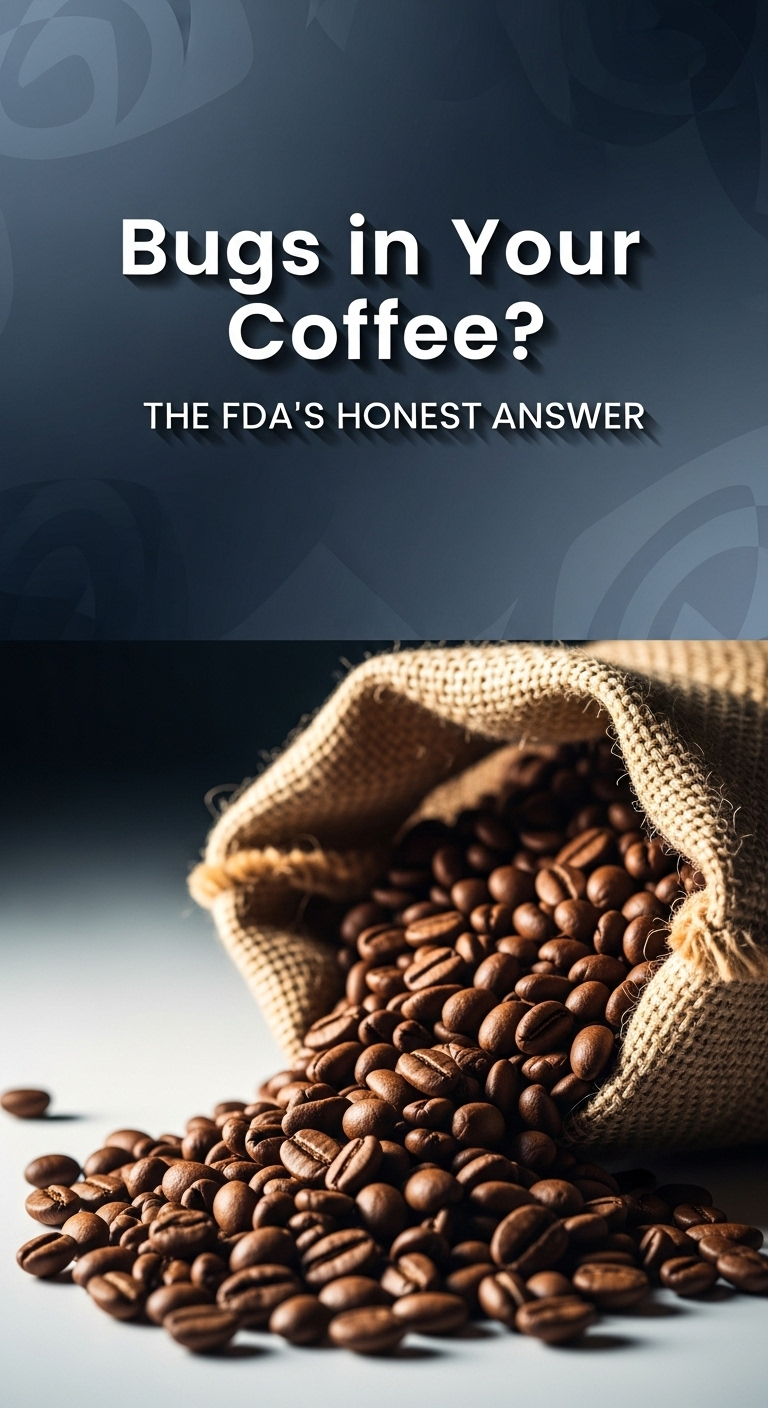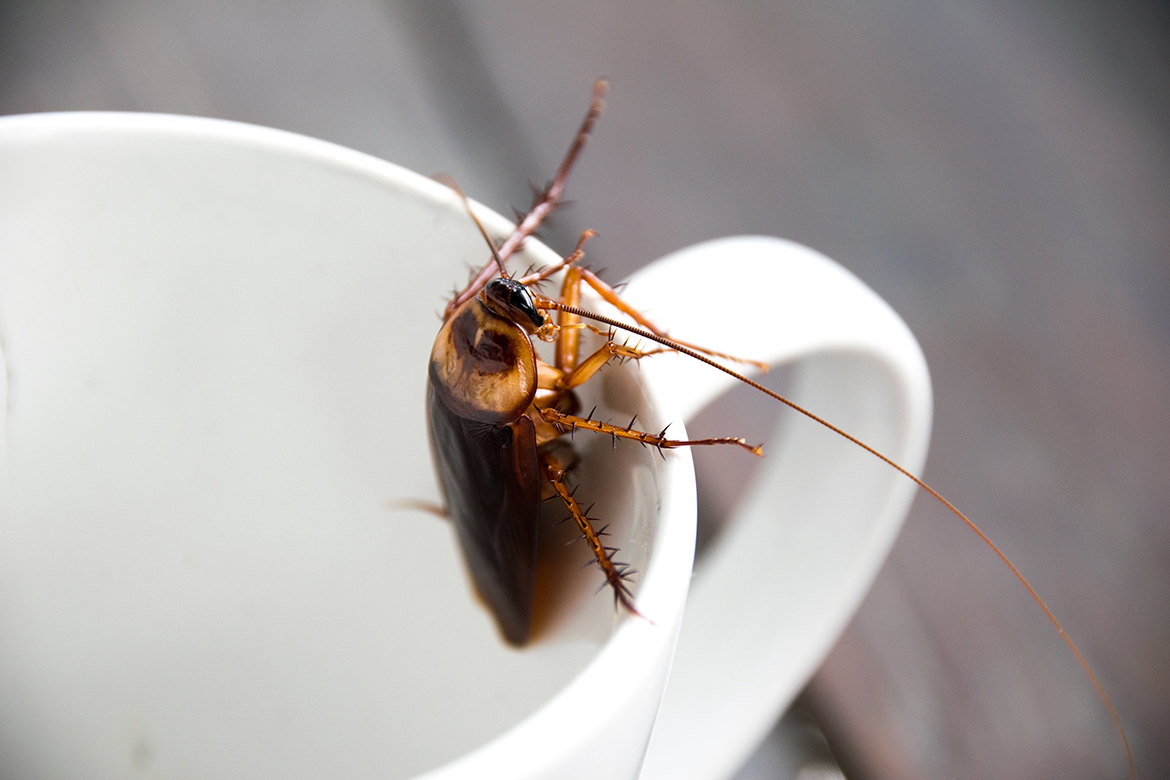As an Amazon Associate CoffeeXplore.com earns from qualifying purchases.
Bugs in Your Coffee? The FDA’s Honest Answer
It’s the question that might make you look at your morning cup a little differently: are there bugs in coffee beans? You’ve likely heard the rumors—whispers of ground-up cockroaches and unavoidable insect parts making their way into your daily brew. It’s a unsettling thought that can leave you wondering about the safety and purity of one of the world’s most popular beverages.
Yes, it is entirely possible for both coffee beans and pre-ground coffee to contain trace amounts of insect fragments, including from cockroaches. However, this is a recognized, monitored, and regulated aspect of food production for many agricultural products, including coffee, by agencies like the FDA.
This guide cuts through the sensationalism to give you the facts. Leveraging extensive analysis of official regulations and expert commentary, we’ll unpack precisely how insects can enter the coffee supply chain, what the acceptable levels are, the actual health implications, and—most importantly—what you can do to significantly minimize your exposure. This isn’t about fear; it’s about being an informed coffee drinker.
Key Facts
- Official Allowance: The U.S. Food and Drug Administration (FDA) has a “Defect Action Level” that permits up to an average of 10% of green coffee beans by count to be insect-infested or insect-damaged before action is required.
- Farm-to-Grinder Contamination: Insects don’t just appear in the factory. Contamination can happen at multiple stages, from natural infestation by pests like the Coffee Berry Borer on the plant to insects like cockroaches entering large storage stockpiles.
- Pre-Ground Coffee Poses a Higher Risk: According to industry experts, pre-ground coffee is more likely to contain bug fragments because it’s often processed from massive, mixed stockpiles where sorting out all defects is nearly impossible.
- Generally Safe, But Allergies Are a Concern: For the vast majority of people, these trace amounts are harmless. However, as noted by entomologists, individuals with a specific allergy to cockroaches may experience reactions like headaches or congestion.
- Whole Beans Are the Solution: The most effective way to reduce the likelihood of consuming insect fragments is to buy high-quality whole bean coffee and grind it yourself right before brewing.
The Straight Answer: Are There Bugs in Your Coffee?
Let’s get right to it. Yes, it is possible for both coffee beans and ground coffee to contain trace amounts of insect fragments, including from cockroaches. This is a recognized and regulated aspect of food production for many agricultural products.

It sounds alarming, but this is a reality for nearly all mass-produced agricultural goods, from wheat flour to canned tomatoes. It’s not a sign of a dirty factory but rather an unavoidable consequence of growing and harvesting natural products in the real world. Official bodies like the U.S. Food and Drug Administration (FDA) acknowledge this reality and have standards in place to ensure what reaches you is safe.
It sounds alarming, but is it actually a cause for concern? Let’s look at the facts. The presence of these “defects” is not an uncontrolled free-for-all. Instead, it’s a carefully monitored aspect of the global food supply.
How Do Insects End Up in Coffee? The Journey from Farm to Grinder
Understanding how insects enter the coffee supply chain helps demystify the issue. It’s not a simple case of bugs falling into a grinder at the factory; it’s a multi-stage process rooted in agriculture. The journey from a coffee cherry on a branch to the grounds in your brewer presents several opportunities for insects to get involved.
Did you know? The main culprits aren’t just cockroaches, but specific agricultural pests like the Coffee Berry Borer that infest the bean right on the plant!
Here is the step-by-step journey where contamination can occur:
- Natural Infestation in the Field: It all starts on the coffee farm. Coffee plants, like any other crop, are susceptible to pests. The most notorious is the Coffee Berry Borer (Hypothenemus hampei), a tiny beetle that burrows directly into the coffee cherry to lay its eggs, damaging the bean inside. When these infested cherries are harvested, the insects can be carried along with them.
-
Storage and Stockpiles: After harvesting and initial processing, green (unroasted) coffee beans are stored in massive stockpiles, often for extended periods. These large, static piles of organic material can attract pests. This is where cockroaches and other insects, like the Coffee Bean Weevil (Araecerus fasciculatus), can become a significant issue. As entomologist Dr. Douglas Emlen has pointed out, once these large stockpiles become infested, it’s incredibly difficult to filter out all of the contaminants.
-
Processing & Grinding: The final stage is where these fragments become part of the product. While modern processing includes cleaning and sorting steps, removing every single insect fragment from tons of tiny beans is a practical impossibility. When these beans are ground en masse—especially for pre-ground coffee—any insect parts that remain get roasted and pulverized right along with the beans themselves. Roasting at high temperatures neutralizes any pathogens, but the physical fragments can remain.

What the FDA Says: Understanding “Defect Action Levels”
This is where government regulation provides crucial context and reassurance. The U.S. Food and Drug Administration (FDA) doesn’t expect our food to be 100% sterile and free of any natural defects. It would be impossible to achieve and would make food prohibitively expensive. Instead, they establish what are known as “Defect Action Levels” (DALs).
A DAL is the maximum level of natural or unavoidable defects in foods that present no health hazard for humans.
For green coffee beans, the FDA’s specific standard is as follows: “Average 10% or more by count are insect-infested or insect-damaged.”
This means that if a batch of green coffee beans is inspected and, on average, more than 10% of the beans show signs of insect damage or infestation, the FDA can take action to seize the product. It’s a ceiling, not a floor.
Remember, this FDA level is a limit for action, not the typical amount found. Reputable manufacturers aim to be well below this level to ensure a high-quality product. This isn’t unique to coffee; many common foods have similar allowances.
| Food Product | FDA Defect Action Level Guideline |
|---|---|
| Green Coffee Beans | Up to 10% of beans by count can be insect-infested or damaged. |
| Wheat Flour | Average of 75 or more insect fragments per 50 grams. |
| Canned Tomatoes | Average of 10 or more fly eggs per 500 grams. |
| Peanut Butter | Average of 30 or more insect fragments per 100 grams. |
Seeing these numbers side-by-side helps normalize the situation. The presence of trace insect fragments is a regulated and accepted part of our modern food system, not a specific problem unique to coffee.
Health Implications: Are Insect Fragments in Coffee Harmful?
This is the bottom-line question for most people: Is it safe to drink coffee that might contain bug parts? For the overwhelming majority of the population, the answer is a clear yes.

Here’s a breakdown of the health considerations:
- For the General Population: The trace amounts of insect fragments allowed by the FDA are not considered harmful. The high temperatures of the roasting process would neutralize any potential bacteria or pathogens associated with the insects. Essentially, you are consuming tiny, sterile specks of protein that have no negative health impact.
- For Individuals with Specific Allergies: This is the most important exception. Cockroaches are a known and potent allergen, capable of triggering asthma and other allergic reactions in sensitive individuals. The primary health concern related to bugs in coffee is not one of toxicity or infection, but of a specific allergic reaction. If you have a known cockroach allergy and consistently experience symptoms after drinking coffee, the insect fragments could be a contributing factor.
If you consistently experience allergy-like symptoms after drinking pre-ground coffee, it might be worth discussing with a doctor or trying whole beans. Symptoms could include headaches, nasal congestion, or a runny nose. The connection is considered more likely with pre-ground coffee, where the concentration of fragments from stockpiled beans may be higher.
How to Minimize Bugs in Your Brew: Whole Bean vs. Pre-Ground Coffee
Now for the actionable advice. If the idea of consuming any amount of insect fragments is unappealing, you have a powerful and effective way to take control. The single best step you can take is to switch from pre-ground coffee to whole bean coffee.
The logic is simple and based on coffee industry processing practices. Pre-ground coffee is typically a blend made from massive quantities of beans sourced from various locations. These are the large stockpiles where infestation is most likely and hardest to control.
Whole beans, particularly those marketed as specialty or single-origin, are often subject to stricter quality control. The beans are selected for their pristine condition, and it’s much easier for both producers and consumers to visually inspect whole beans for defects.
Here is a direct comparison to help you make your choice:
| Feature | Pre-Ground Coffee | Whole Bean Coffee |
|---|---|---|
| Source | Often from large, mixed stockpiles | Typically higher quality, selected beans |
| Contamination Risk | Higher, due to mass processing | Lower, easier to inspect and sort |
| Recommendation | Convenient, but higher risk | Recommended for minimizing insect fragments |
By buying whole beans and grinding them fresh at home right before you brew, you are not only getting massively better flavor and aroma, but you are also selecting for a higher grade of coffee that is far less likely to have passed through the processes where significant contamination occurs.
For those who want to ensure the purest possible cup, investing in a quality coffee grinder is the most effective step. Grinding your own beans not only minimizes the risk of contaminants but also unlocks the freshest, most vibrant flavors, transforming your daily coffee ritual.
FAQs About Bugs in Coffee Beans
Do all coffee beans have insects?
While not every single bean or every single bag will have them, all coffee, as a natural agricultural product, carries some risk of containing trace elements of insects. It’s an inherent part of farming and processing. The FDA regulates the acceptable amount to ensure the final product is safe for consumption.
Are coffee bean bugs real?
Yes, coffee bean bugs are very real. Specific agricultural pests like the Coffee Bean Weevil (Araecerus fasciculatus) and the Coffee Berry Borer (Hypothenemus hampei) are well-known in the coffee industry. They are a primary source of insect damage to green coffee beans before they are even roasted.
What are the symptoms of a cockroach coffee allergy?
According to expert sources, the concern is for individuals with a pre-existing cockroach allergy. Potential symptoms linked to consuming coffee containing cockroach allergens could include:
* Headaches
* A runny nose
* Nasal congestion
These symptoms are more likely to be noticed when drinking pre-ground coffee due to the higher potential for contamination from large stockpiles.
Can you burn coffee grounds to keep bugs away?
Yes, this is a related but separate topic. Many people burn used, dry coffee grounds as a natural way to repel pests like mosquitoes and other bugs. The strong scent released when the grounds are burned is believed to act as a deterrent. This is a popular way to repurpose old grounds after you’ve brewed your coffee.
Is this issue worse in pre-ground coffee?
Yes, the issue of insect contamination is widely considered to be more prevalent in pre-ground coffee. This is because it is often processed from enormous stockpiles of beans where infestations are more likely to occur and are much harder to sort out compared to the higher-quality, often hand-selected beans used for whole bean coffee products.
Final Summary: Drink Your Coffee with Confidence
The thought of bugs in coffee can be jarring, but the reality is far less sensational than the headlines suggest. Based on official regulations and expert analysis, we can see that this is a managed and understood aspect of our global food system, not a sign of poor quality or uncleanliness.
Now that you have the facts, you can make an informed choice about the coffee you buy and drink.
- It’s a Regulated Reality: Trace amounts of insect fragments are an unavoidable defect in many agricultural products, and the FDA sets strict limits to ensure safety.
- Health Risks are Minimal for Most: Unless you have a specific and severe cockroach allergy, these trace fragments pose no health risk.
- You Have Control: The most powerful tool for minimizing your exposure is choosing high-quality whole bean coffee and grinding it fresh at home.
Ultimately, you don’t need to give up your beloved coffee. By understanding the process and making a simple switch to whole beans, you can enjoy your daily cup with both confidence and peace of mind.
Share this article to help debunk the myths for others
Last update on 2025-12-15 / Affiliate links / Images from Amazon Product Advertising API

